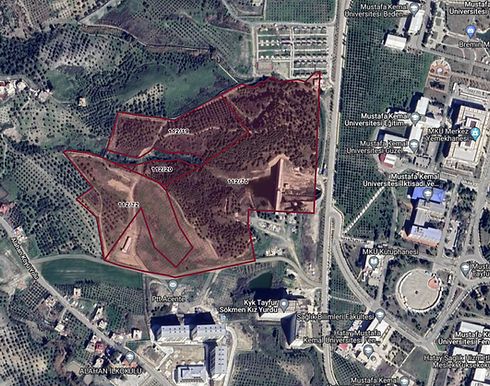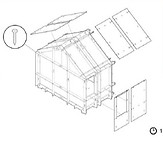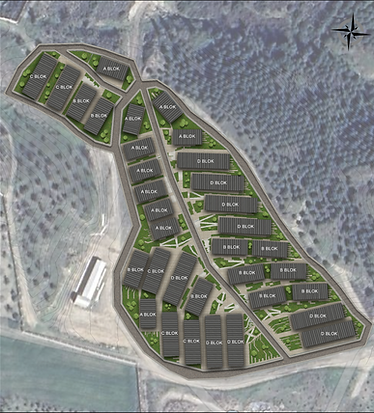
BLOCKS
FOR
HOPE
A new city is possible
SNAPSHOT


What Is Unique About Blocks for Hope?
Plot secured and permits already obtained; protocols already signed with JAV, University and AFAD
Modular, prefabricated architecture, with construction period of only 90 days.
Located within the University campus; easily accessible and enables a sense of belonging and community for its residents.
Long term investment into education and the future of ‘Hatay’ while providing much needed temporary shelter to Earthquake survivors in the medium term.
Sustainable houses made of adobe, which is a highly durable and non-toxic material with excellent thermal performance.

DESIGN
We're building a new beginning, a new life.
The primary objective is to provide earthquake survivors with functional, safe, practical, and sustainable housing areas allowing to meet their social needs, including minimum public utilities (electricity, water, natural gas, internet), that are resistant to disasters, so that they can satisfy their basic humanitarian needs.

Design Decisions
All units are designed as two-
storey and with the ability to
utilize natural light.
Materials
Hybrid materials using:
the compatibility of
adobe and steel.
Modules
Modular apartments with
4 different plans, designed for
2, 6 and 10 people.
Greenery
Many shaded areas, green
spaces.
STRUCTURES

Baghdadi Structures
It is one of the traditional and original wall construction techniques.
Functionality
-
Ensures horizontal continuity of the wall.
-
Its hollow structure extends the life of the wooden frame.
-
It provides material saving as it is made with very thin plates.

“Sofali” Plan
It refers to the spaious areas where the doors of rooms are opened in Anatolain Turkish Houses.
Functionality
-
The sofa has many functions such as circulation, gathering, sitting and resting.
-
The unused sides in room transitions are transformed into seating elements called "sedir" by slightly raising them.

Climate Crisis & Sustainability
Climate crisis is defined as a situation that causes negative climate change.
-
The first measure to be taken in the initial stage is to increase the use of renewable energy sources.
Sustainability is defined as meeting our own needs through natural processes.
-
It is essential to recognize that resources are limited.

Modularity
A module is defined as units
that complement each other
and undertake different
functions.
Modularity, on the other hand,
is a special type of design that
creates a high degree of
independence or "free
assembly" between the units.
ADOBE BUILDINGS
Adobe is a traditional material made from a mixture of earth and lime, which is kneaded with water and dried in the sun to gain strength as a construction material.
It has a high heat storage capacity, keeping warmth within its structure without requiring additional materials or layers.
It is a reusable, recyclable, and environmentally friendly material.
It is cost-effective since it can be produced on-site. It also doesn't require any special facility or equipments. Adobe is easy and fast to use for shell & core.

BLOCKS AND MODULES
-
10 A Blocks
-
10 B Blocks
-
5 C Blocks
-
9 D Blocks
-
Educational Facilities
-
Markets
-
Place of Worship
-
Hospital

MODULE PLAN SCHEMES

-
1 Double Bed
-
1 Sofa Bed
-
Seating Area
-
Kitchen
-
Bathroom
-
30 sqm
246 units

-
1 Double Bed
-
1 Sofa Bed
-
Dining Area
-
Seating Area
-
Kitchen
-
Bathroom
-
38 sqm
60 units

-
1 Double Bed
-
3 Single Beds
-
Dining Area
-
Seating Area
-
Kitchen
-
Bathroom
-
52 sqm
20 units
BLOCK SCHEMES: BLOCK A
A total of 16 people can stay in Block A, where 8 people can stay on the ground floor and 8 people can stay on the first floor.
Module 1 x 8 units = 16 people
TOTAL = 16 PEOPLE

BLOCK SCHEMES: BLOCK B
A total of 24 people can stay in Block B, where 12 people can stay on the ground floor and 12 people can stay on the first floor.
Module 2 x 4 units = 16 people
Module 1 x 4 units = 8 people
TOTAL = 24 PEOPLE

BLOCK SCHEMES: BLOCK C
A total of 36 people can stay in Block C, where 18 people can stay on the ground floor and 18 people can stay on the first floor.
Module 3 x 4 units= 20 people
Module 2 x 4 units = 16 people
TOTAL = 36 PEOPLE

BLOCK SCHEMES: BLOCK D
A total of 28 people can stay in Block D, where 14 people can stay on the ground floor and 14 people can stay on the first floor.
Module 1 x 14 units = 28 people
TOTAL = 28 PEOPLE
